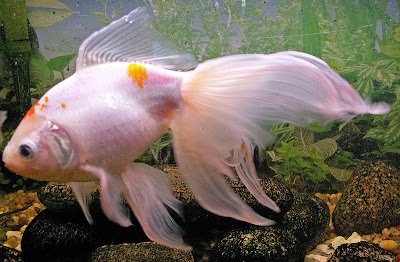The pearlscale or chinshurin in Japanese, is a spherical-bodied fancy goldfish with finnage similar to the fantail.
Description
The characteristic feature of the pearlscale is its thick, domed scales with pearl-like appearance. Its body is round and similar to a golf ball. The finnage may be long or short. Pearlscales can reach up to 8 inches long and grow up as large as oranges. However, pearlscale fancy goldfish are prone to swimbladder disorders which affect the ability to maintain normal position in the water. This is attributed to the selective breeding process of fancy goldfish to achieve particular body forms, such as that of the pearlscale's. Selective breeding gradually resulted to the alteration of the appearance of the swimbladder.
The pearlscale standard is as follows:
- Depth of body to be greater than 2/3rds of body length
- Scales to be domed
- Dorsal fin to be single, all other fins to be paired.
- Caudal fin to be divided and forked and held above the horizontal.
- Extremities of fins to have a slightly rounded appearance.
- Minimum length of body to be 5.5 cm (2¼ inches).
The fish should be bright and alert and displaying well developed domed scales all over the body area. The body should be short and rounded (not elongated). The caudal fin should be held high without signs of drooping and well divided. Quality fish will have high colour intensity extending into the fins.
Coloration
Pearlscales come in every color variety.
The colour may be metallic (self-coloured or variegated in a pleasing pattern and similar on each side) or calico. Metallic colours should appear as burnished metal, extending into the fins. Calico fish should have a blue background with patches of violet, red, orange, yellow and brown, spotted with black.
Variants
Pearlscales are found without headgrowth, with Oranda-like headgrowth or with two large bubble domes. The bubble-domed Pearlscales are known as high-head pearlscale, crown pearlscale or Hama nishiki.
Special requirements
Pearlscales are egg shaped with internal organs crowding the creature's compact body, therefore overfeeding should be avoided. Pearlscales are very sensitive to cold water and should not be exposed to temperature readings below 55°F (13°C). If you get a pearlsale also be careful as they are quite prone to pH changes and should be kept out of long periods exposed to a high acidity or alkalinity.
Full Story >>




